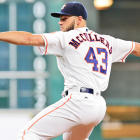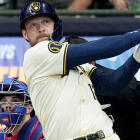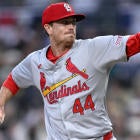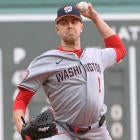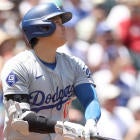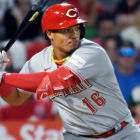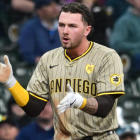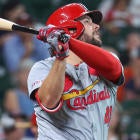Conventional wisdom when it comes to pitching has always held that you pitch off the fastball. Your secondary offerings are the accoutrements, while the fastball is the main attraction. It’s the pitch you rely on when you need to throw strikes, sure, but it’s also the pitch you use to set up your breaking pitches; a high fastball sets up a curveball low to put a batter away.
Leaguewide, combined usage of fastballs -- of the four-seam and two-seam variety -- and sinkers has averaged right around 60 percent in the 10 years we have PITCHf/x data, courtesy of FanGraphs.com. However, it is worth noting that 2016 is the lowest year on record, at 56.6 percent, and we saw a number of high profile pitchers take that approach. That list is largely made up of pitchers with fairly middling fastballs -- Masahiro Tanaka, Marco Estrada, Kenta Maeda… These pitchers all had success with their approaches in 2016, but none have fastballs as their calling card
This is where Lance McCullers stands out. He certainly isn’t a soft-tosser, ranking in the 77th percentile in fastball velocity last season, however his four-seamer hasn’t been his best pitch in the majors. Not even close, as his .324 batting average and .188 ISO allowed on the pitch indicate, per BrooksBaseball.com. For all of his velocity, McCullers had just a 5.8 percent swinging strike rate with the pitch last season, which comes in at just the 31st percentile.
Of course, given that McCullers has a career 3.22 ERA and 27.0 percent strikeout rate, it’s pretty clear that fastball isn’t much of a liability. If it hasn’t been a pitch that has gotten him great results with in the majors, it hasn’t been enough to limit him mostly because his curveball might just be the best secondary offering in baseball.
In 2016, McCullers threw his curveball 647 times, making him one of exactly 100 pitchers to throw their curveball at least 200 times. Among that group of 100, McCullers ranked seventh in whiff-per-swing rate, and second in overall whiff rate. What makes the pitch so impressive is that McCullers ranked that high despite throwing it far more than anyone else. McCullers threw his curveball 49.5 percent of the time -- no other pitcher was above 42.4 percent -- and batters still couldn’t do anything with it.
If you went up to the plate just guessing what McCullers was going to throw, you had a 50-50 chance of being right if you sat curveball. And yet opposing hitters managed just a .137 batting average and .055 ISO on the pitch. He racks up huge numbers of groundballs and swings and misses with the pitch, and those tendencies play up further due to the fact that he garners a 50.4 percent swing rate on the pitch, the second-highest mark in baseball.
Of course, just guessing would never get you anywhere as a major-league hitter, and McCullers makes it especially tough. He keeps about 10 MPH difference between his fastball and his curveball, with his changeup coming in at 89.3 MPH last season to split the difference, and he has shown a keen ability to locate his pitches to make things most difficult for opposing batters. Check out his pitch locations for each type of pitch, courtesy of BaseballSavant.com:
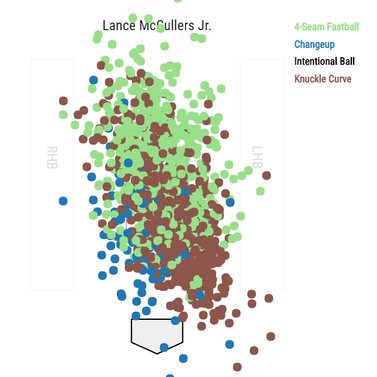
McCullers plays both pitches off each other beautifully, pounding right-handed batters up and in with the fastball, and then hitting them with the curveball down and away. With the kind of tight, late break he gets on his curveball, it makes sense that batters would have trouble differentiating between the two. A batter will have to start his swing early if he wants to catch up to an up-and-in fastball, which is going to leave him vulnerable to rolling over the low-and-away curveball. If he can even make contact with it.
McCullers may not rely on the curveball quite as much this season. If hitters start to sit on the curveball, it may be less effective. Of course, he can just revert to a more fastball-heavy approach as he did in 2015 when he recorded 9.24 K/9 and a 3.22 ERA (3.26 FIP, 3.50 FIP) while throwing his curveball just 36.3 percent of the time.
There are real concerns about McCullers, of course. Though he was able to avoid the control issues that plagued him in the minors as a rookie, they crept back up in 2016, as he walked 12.8 percent of opposing hitters. He also missed time in 2016 with an elbow injury, and has thrown just 206 2/3 innings over two major-league seasons as a result. Those questions are why he is going off the board 170th overall at FantasyPros.com, making him a 15th-round pick.
At that point, there really isn’t much downside to McCullers, who has shown clear ace upside so far. If all he manages to do this season is match his track record over a full season, he’s going to be a top-15 pitcher. In 206 2/3 career innings, he has a 3.22 ERA, 1.33 WHIP, and 235 strikeouts. That kind of upside is impossible to ignore.








